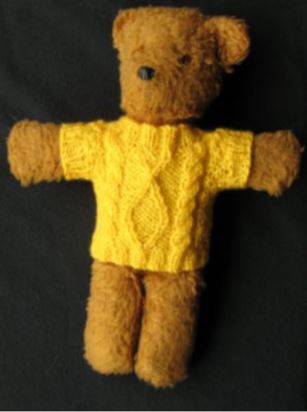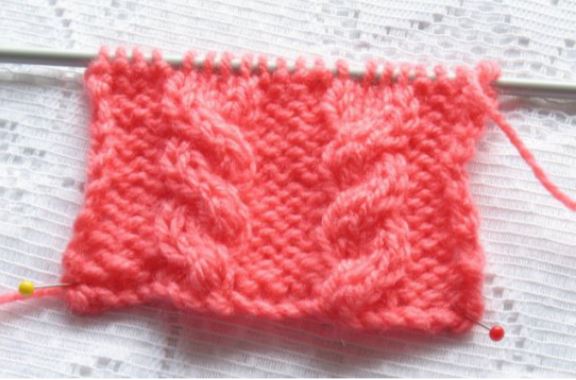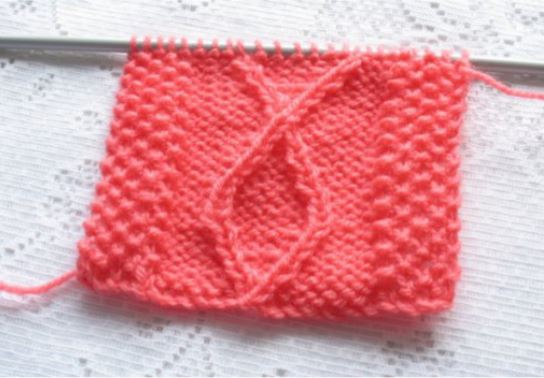Cables are a feature of Aran garments. They are formed by twisting knit stitches around each other as you knit them. They tend to be created from knit stitches on a background of reverse stocking stitch (stockinette) as that makes the cable stitches stand out from the background.
Many effects and patterns can be created using different numbers of stitches and different ways of twisting them. It’s fairly important to double-check the abbreviations on the pattern you are using as some designers will use a term such as C4B while others will use the term C2B to mean exactly the same thing.

The teddy bear jumper above is worked with double moss stitch (seed stitch) at the edges and two four stitch cable ‘ropes’ up each side of the central diamond pattern. The ribbing is 2×2 rib. As everyone’s teddy bear will be a different size it’s just not practicable to include the full pattern for the jumper. It’s included here to inspire you to create your own designs!
The individual cable patterns are described below.
Four stitch cable – version 1 twisting to the right (C4B)
C4B – slip the next 2 stitches onto a cable needle together without twisting them. Put the cable needle to the back of the work. Knit the next 2 stitches. Knit 2 stitches from the cable needle.
Worked over 4 knit stitches on background of reverse stocking stitch (stockinette).
- Row 1: (right side of work) K4
- Row 2: P4
- Row 3: C4B
- Row 4: P4
- Repeat these 4 rows

Four stitch cable – version 2 twisting to the left (C4F)
C4F – slip the next 2 stitches onto a cable needle without twisting them. Put the cable needle to the front of the work. Knit the next 2 stitches. Knit 2 stitches from the cable needle.
Worked over 4 knit stitches on a background of reverse stocking stitch (stockinette).
- Row 1: (right side) K4
- Row 2: P4
- Row 3: C4F
- Row 4: P4
- Repeat these 4 rows.
Single chain diamond worked over 8 stitches
Abbreviations:
- T2L – Twist 2 to the left. Slip the next stitch onto a cable needle and place to the front of the work. Purl the next stitch. Knit the stitch from the cable needle.
- T2R – Twist 2 to the right. Slip the next stitch onto a cable needle and place to the back of the work. Knit the next stitch. Purl the stitch from the cable needle.
- C2B – Cable 2 back. Slip the next stitch onto a cable needle and place to the back of the work. Knit the next stitch. Knit the stitch from the cable needle.
To work the diamond:
- Row 1, p3, C2B, p3
- Row 2 and every wrong side row following: Knit the knits and purl the purls
- Row 3: P2, T2R, T2L, p2
- Row 5: p1, T2R, p2, T2L, p1
- Row 7: T2R, p4, T2L
- Row 9: k1, p6, k1
- Row 11: T2L, p4, T2R
- Row 13: p1, T2L, p2, T2R, p1
- Row 15: p2, T2L, T2R, p2
- Row 16: k3, p2, k3
- These 16 rows create the pattern and can be repeated right up the garment.

